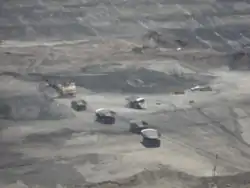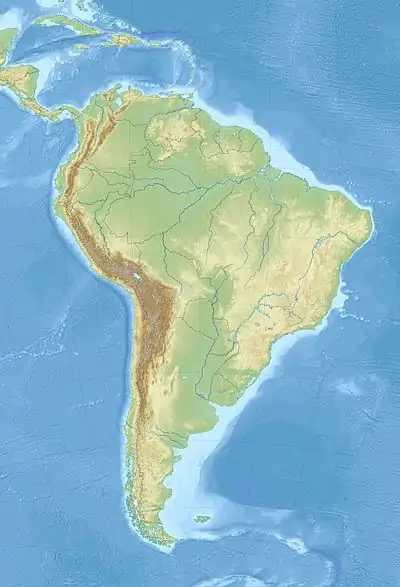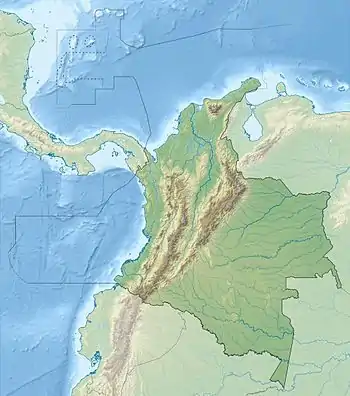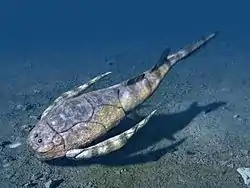| Cerrejón Formation | |
|---|---|
| Stratigraphic range: Mid-Late Paleocene ~ | |
 Section of the Cerrejón coal mine | |
| Type | Geological formation |
| Unit of | Cesar-Ranchería Basin |
| Sub-units | Lower, middle, upper |
| Underlies | Tabaco Formation |
| Overlies | Manantial Formation |
| Thickness | Up to 750 m (2,460 ft) |
| Lithology | |
| Primary | Coal, mudstone, siltstone |
| Other | Sandstone |
| Location | |
| Coordinates | 11°05′22″N 72°40′31″W / 11.08944°N 72.67528°W |
| Region | La Guajira, Cesar |
| Country | |
| Type section | |
| Named for | Cerrejón |
| Named by | Hammen |
| Location | Cerrejón |
| Year defined | 1958 |
| Coordinates | 11°05′22″N 72°40′31″W / 11.08944°N 72.67528°W |
| Approximate paleocoordinates | 8°30′N 59°12′W / 8.5°N 59.2°W[1] |
| Region | La Guajira |
| Country | |
The Cerrejón Formation is a geologic formation in Colombia dating back to the Middle-Late Paleocene. It is found in the El Cerrejón sub-basin of the Cesar-Ranchería Basin of La Guajira and Cesar. The formation consists of bituminous coal fields that are an important economic resource. Coal from the Cerrejón Formation is mined extensively from the Cerrejón open-pit coal mine, one of the largest in the world. The formation also bears fossils that are the earliest record of Neotropical rainforests.[2]
Definition
The formation was first named Septarias Formation and in 1958 renamed to Cerrejón Formation by Thomas van der Hammen, probably based on an earlier report by Notestein.[3]
Geology
The Cerrejón Formation, with an assigned total thickness of 750 metres (2,460 ft),[3] is subdivided into lower, middle, and upper groups based on the thickness and distribution of coal beds. On average the coal beds are 3 metres (9.8 ft) thick, and range from 0.7 metres (2.3 ft) to 10 metres (33 ft) in thickness. The thickest beds are in the upper part of the formation.[4] The Cerrejón Formation is laterally equivalent with the Los Cuervos and Bogotá Formations to the south; Llanos Orientales and Altiplano Cundiboyacense respectively. The formation is also time-equivalent with the Marcelina Formation of the Venezuelan Serranía del Perijá and the Catatumbo Formation of the southwestern Colombian part of the Maracaibo Basin, the Catatumbo Basin.[5] The formation has also been described as laterally equivalent to the Mostrencos and Santa Cruz Formations of Venezuela.[6]
Based on lithofacies associations and paleofloral composition, the depositional environment fluctuated from an estuarine-influenced coastal plain at the base of the formation to a fluvial-influenced coastal plain at the top.[7]
In the geologically recent past, some coal in the formation has spontaneously and naturally combusted to form clinker, red and brick-looking burnt coal. These rocks outcrop irregularly and are up to 100 metres (330 ft) thick. Clinker is found near deformed zones such as faults or tight folds, and is older than the deformities themselves. They are thought to have combusted after the development of the Cerrejón thrust fault and alluvial fan.[8]
Paleoenvironment

Fossils found from the Cerrejón Formation are the earliest record of Neotropical rainforests, with an abundance of plant macrofossils and palynomorphs. The Cerrejón Formation also records a riverine vertebrate fauna that includes lungfish, turtles, snakes, and crocodyliforms. Based on these fossils and the stratigraphy of the formation, the Cerrejón Formation was likely formed on a coastal plain, covered in a wet tropical rainforest and incised by a large river system.[9]
The rainforest is estimated to have been around 5°N paleolatitude.[2] During the Paleocene, equatorial temperatures were much higher than they are today. Based on the size of the giant boid Titanoboa, specimens of which have been found in the Cerrejón Formation, the mean annual temperature of Paleocene equatorial South America was between 30 °C (86 °F) and 34 °C (93 °F). This is the minimum annual temperature range that a poikilotherm as large as Titanoboa could live.[9] It is consistent with Paleocene climate models which predict greenhouse temperatures and an atmospheric pCO2 concentration of around 2,000 parts per million.[10] Paleotemperature estimates based on fossil leaf assemblages from the Cerrejón Formation predict the mean annual temperature to be 6 to 8 °C (11 to 14 °F) lower than other estimates.[11] However, such temperature estimates based on riparian and wetland rainforest paleoflora have been considered underestimates.[12]
Mean annual temperatures of 30 to 34 °C (86 to 93 °F) are considered to be too high for modern tropical forests,[13] but the Cerrejón rainforest could have been maintained by increased atmospheric pCO2 levels and the high regional rainfall, which is estimated to have been around 4 metres (13 ft) per year.[7][9][14]
Flora
.jpg.webp)
The floral record of the Cerrejón Formation is well known, with many identifiable and well preserved plant microfossils having been found from the Cerrejón mine. The fossils are well preserved, and in some cases their cell structure is intact.[15] In comparison to modern Neotropical rainforests, the diversity of plants is quite low. This may be an indication of the early stage of Neotropical diversification, or a delayed recovery period following the Cretaceous–Paleogene extinction event.[2]
Many plants from the Cerrejón Formation belong to families that are still common today in modern Neotropical rainforests. There is a diverse variety of palms and legumes in the formation. In addition to palms and legumes, much of the biomass of the Paleocene forest consisted of laurales, malvales, menisperms, aroids, zingiberaleans, cocoa bean plants,banana plants, and avocado plants.[2] Studies of fossil plants from Cretaceous-age sites indicate that the floral composition below the Cretaceous–Paleogene boundary (K–T boundary) was very different from that of the Paleocene. Legumes are absent from Cretaceous strata, and likely appeared or diversified during the Paleocene.[15]
The presence of these types of flora in Paleocene strata shows that plants characteristic of modern Neotropical rainforests have existed for geologically long periods of time, being able to withstand climatic and geographic changes in South America. It has been suggested that today's Neotropical rainforests are the result of environmental changes brought about by Quaternary glacial cycles (i.e. the recent ice age). These cycles would have caused fluctuation in the diversity and extent of rainforests. If this was the case, the current diversity of the Amazon rainforest would be a recent speciation in a changing environment.[16] However, the floral record from the Cerrejón Formation shows that the current diversity of the Amazon Rainforest can be traced back into the early Cenozoic.[2]
Fauna

Feeding damage from insects is evident on some of the plant macrofossils from the Cerrejón Formation. One survey of plant macrofossils showed that around half of the studied specimens had been attacked by herbivorous insects.[2] The insects that damaged the leaves were predominantly generalist feeders, unlike modern Neotropical insects that are mainly specialist herbivores. There is no evidence of the elevated insect-feeding diversity or host-specialized feeding associations that are seen in later Neotropical forests. The insect diversity in the Cerrejón Formation is low in comparison to the diversity of insects in Neotropical rainforests today, and it is likely that leaf damage was made by relatively few species.[2]
Remains of the giant boid Titanoboa cerrejonensis have been found from a gray claystone layer underlying Coal Seam 90 in the Cerrejón mine. Titanoboa is the largest known snake to have ever existed, reaching an estimated length of 12.8 metres (42 ft). Eunectes, the anaconda, is likely to be a close living analogue of Titanoboa.[9]
A dyrosaurid crocodylomorph called Cerrejonisuchus improcerus was described in 2010 from the Cerrejón Formation in the same layer as Titanoboa. It was a small dyrosaurid, and had the shortest snout length relative to its skull length of any dyrosaurid. Most dyrosaurids were marine, with long snouts adapted for catching fish. The short snout of Cerrejonisuchus is likely to have been an adaptation for a more generalized diet in a transitional aquatic environment.[17] It is possible that Cerrejonisuchus was a food source for Titanoboa, as the two inhabited the same riverine environment.[18] The anaconda has been documented consuming caimans, a feeding habit that is similar to the inferred habit of Titanoboa. A second dyrosaurid, Acherontisuchus, was named in 2011 from the formation. With a large body and long snout, it resembles most other dyrosaurids.[19] A third dyrosaurid, Anthracosuchus, was named in 2014. Unlike other dyrosaurids, it had blunt teeth and a short skull. Anthracosuchus likely had massive jaw muscles allowing it to feed on large turtles, a behavior which is corroborated by predation marks found at the site.[20]
Coal resources

The Cerrejón Formation contains extensive coal seams that are mined primarily at the Cerrejón mine. The coal is desirable for its low ash and sulfur content and for its resistance to caking. Cerrejón is Colombia's largest coal producing mine, with most of the production exported to Europe. It is the largest coal mining operation in Latin America, with an estimated 28.4 million tons mined in 2006.[4][21]
Itaboraian correlations
| Formation | Itaboraí | Las Flores | Koluel Kaike | Maíz Gordo | Muñani | Mogollón | Bogotá | Cerrejón | Ypresian (IUCS) • Wasatchian (NALMA) Bumbanian (ALMA) • Mangaorapan (NZ) |
|---|---|---|---|---|---|---|---|---|---|
| Basin | Itaboraí | Golfo San Jorge | Salta | Altiplano Basin | Talara & Tumbes | Altiplano Cundiboyacense | Cesar-Ranchería |  Cerrejón Formation (South America) | |
| Country | |||||||||
| Carodnia | |||||||||
| Gashternia | |||||||||
| Henricosbornia | |||||||||
| Victorlemoinea | |||||||||
| Polydolopimorphia | |||||||||
| Birds | |||||||||
| Reptiles | |||||||||
| Fish | |||||||||
| Flora | |||||||||
| Environments | Alluvial-lacustrine | Alluvial-fluvial | Fluvio-lacustrine | Lacustrine | Fluvial | Fluvio-deltaic | |||
| Volcanic | Yes | ||||||||
References
- ↑ La Puente Pit in the Paleobiology Database
- 1 2 3 4 5 6 7 Wing et al., 2009
- 1 2 Rodríguez & Londoño, 2002, p.163
- 1 2 Tewalt, S. J.; Finkelman, R. B.; Torres, I. E.; Simoni, F. (2006). "World Coal Quality Inventory: Colombia". In Alex W. Karlsen; Susan J. Tewalt; Linda J. Bragg; Robert B. Finkelman (eds.). World Coal Quality Inventory: South America. U.S. Geological Survey Open File Report 2006. United States Geological Survey. pp. 132–157.
- ↑ Ojeda & Sánchez, 2013, p.69
- ↑ Rodríguez & Londoño, 2002, p.165
- 1 2 Jaramillo, C.A.; Pardo Trujillo, A.; Rueda, M.; Torres, V.; Harrington, G.J.; Mora, G. (2007). "The palynology of the Cerrejon Formation (upper Paleocene) of northern Colombia". Palynology. 31 (1): 153–189. Bibcode:2007Paly...31..153J. doi:10.2113/gspalynol.31.1.153. S2CID 55904256.
- ↑ Quintero, J. A.; Candela, S. A.; Rios, C. A.; Montes, C.; Uribe, C. (2009). "Spontaneous combustion of the Upper Paleocene Cerrejón Formation coal and generation of clinker in La Guajira Peninsula (Caribbean Region of Colombia)". International Journal of Coal Geology. Amsterdam: Elsevier. 80 (3): 196–210. Bibcode:2009IJCG...80..196Q. doi:10.1016/j.coal.2009.09.004. ISSN 0166-5162.
- 1 2 3 4 Head et al., 2009
- ↑ Shellito, C. J.; Sloan, L. C.; Huber, M. (2003). "Climate model sensitivity to atmospheric CO2 levels in the Early–Middle Paleogene". Palaeogeography, Palaeoclimatology, Palaeoecology. 193 (1): 113–123. Bibcode:2003PPP...193..113S. doi:10.1016/S0031-0182(02)00718-6.
- ↑ Herrera, F.; Jaramillo, C.; Wing, S. L. (2005). "Warm (not hot) tropics during the Late Paleocene: First continental evidence". Proceedings of American Geophysical Union Fall Meeting, San Francisco, California, USA. Vol. 86. Washington, D.C. USA: American Geophysical Union. pp. 51C–0608. Bibcode:2005AGUFMPP51C0608H.
{{cite book}}:|journal=ignored (help) - ↑ Kowalski, E. A.; Dilcher, D. L. (2003). "Warmer paleotemperatures for terrestrial ecosystems". Proceedings of the National Academy of Sciences of the United States of America. 100 (1): 167–170. Bibcode:2003PNAS..100..167K. doi:10.1073/pnas.232693599. PMC 140915. PMID 12493844.
- ↑ Burnham, R. J.; Johnson, K. R. (2004). "South American palaeobotany and the origins of neotropical rainforests". Philosophical Transactions of the Royal Society of London B. 359 (1450): 1595–1610. doi:10.1098/rstb.2004.1531. PMC 1693437. PMID 15519975.
- ↑ Hogan, K. P.; Smith, A. P.; Ziska, L. H. (1991). "Potential effects of elevated CO2 and changes in temperature on tropical plants". Plant, Cell & Environment. 14 (8): 763–778. doi:10.1111/j.1365-3040.1991.tb01441.x.
- 1 2 Kanapaux, B. (October 2009). "Plant fossils give first real picture of earliest Neotropical rainforests". Science Stories: Florida Museum of Natural History. Archived from the original on 4 June 2011. Retrieved 14 February 2010.
- ↑ Richardson, J. E.; Pennington, R. T.; Pennington, T. D.; Hollingsworth, P. M. (2001). "Rapid diversification of a species-rich genus of Neotropical rain forest trees". Science. 293 (5538): 2242–2245. Bibcode:2001Sci...293.2242R. doi:10.1126/science.1061421. PMID 11567135. S2CID 20974281.
- ↑ Hastings, A. K; Bloch, J. I.; Cadena, E. A.; Jaramillo, C. A. (2010). "A new small short-snouted dyrosaurid (Crocodylomorpha, Mesoeucrocodylia) from the Paleocene of northeastern Colombia". Journal of Vertebrate Paleontology. 30 (1): 139–162. Bibcode:2010JVPal..30..139H. doi:10.1080/02724630903409204. S2CID 84705605.
- ↑ Kanapaux, B. (2 February 2010). "UF researchers: Ancient crocodile relative likely food source for Titanoboa". University of Florida News. Archived from the original on 8 June 2010. Retrieved 3 February 2010.
- ↑ Hastings et al., 2011
- ↑ Hastings, Alex. "Horse-Hunting Crocodiles and Giant Snakes". Facebook.
- ↑ "El Cerrejón Coal Mine, Colombia". Mining-technology.com. Net Resources International. Retrieved 7 February 2010.
Bibliography
- Hastings, Alexander K.; Jonathan I. Bloch, and Carlos A. Jaramillo. 2011. A new longirostrine Dyrosaurid (Crocodylomorpha, Mesoeucrocodylia) from the Paleocene of north-eastern Colombia: Biogeographocal and behavioural implications for New-World Dyrosayridae. Palaeontology 54. 1095–1116. Accessed 2017-06-14.
- Head, J.J.; J.I. Bloch; A.K. Hastings; J.R. Bourque; E.A. Cadena; F.A. Herrera; P.D. Polly, and C.A. Jaramillo. 2009. Giant boid snake from the paleocene neotropics reveals hotter past equatorial temperatures. Nature 457. 715–718. Accessed 2017-06-14.
- Ojeda Marulanda, Carolina, and Carlos Alberto Sánchez Quiñónez. 2013. Petrografía, petrología y análisis de procedencia de unidades paleógenas en las cuencas Cesar - Ranchería y Catatumbo. Boletín de Geología, Universidad Industrial de Santander 35. 67–80. Accessed 2017-06-14.
- Rodríguez, Gabriel, and Ana Cristina Londoño. 2002. Mapa geológico del Departamento de La Guajira - 1:250,000, 1–259. INGEOMINAS. Accessed 2017-08-08.
- Wing, Scott L.; Fabiany Herrera; Carlos A. Jaramillo; Carolina Gómez Navarro; Peter Wilf, and Conrad C. Labandeira. 2009. Late Paleocene fossils from the Cerrejón Formation, Columbia ((sic)), are the earliest record of Neotropical rainforest. Proceedings of the National Academy of Sciences 106. 18627–18632. Accessed 2017-06-14.
Further reading
- Cadena, Edwin A.; Daniel T. Ksepka; Carlos A. Jaramillo, and Jonathan I. Bloch. 2012a. New pelomedusoid turtles from the late Palaeocene Cerrejón Formation of Colombia and their implications for phylogeny and body size evolution. Journal of Systematic Palaeontology 10. 313–331. Accessed 2017-06-14.
- Cadena, Edwin A.; Jonathan I. Bloch, and Carlos A. Jaramillo. 2012b. New bothremydid turtle (Testudines, Pleurodira) from the Paleocene of northeastern Colombia. Journal of Paleontology 86. 688–698. Accessed 2017-06-14.
- Cadena, Edwin A.; Jonathan I. Bloch, and Carlos A. Jaramillo. 2010. New Podocnemidid Turtle (Testudines: Pleurodira) from the Middle-Upper Paleocene of South America. Journal of Vertebrate Paleontology 30. 367–382. Accessed 2017-06-14.
- Hastings, Alexander K.; Jonathan I. Bloch, and Carlos A. Jaramillo. 2014. A new blunt-snouted dyrosaurid, Anthracosuchus balrogus gen. et sp. nov. (Crocodylomorpha, Mesoeucrocodylia), from the Palaeocene of Colombia. Historical Biology 27. 998–1020. Accessed 2017-06-14.
- Herrera, Fabiany A.; Carlos A. Jaramillo; David L. Dilcher; Scott L. Wing, and Carolina Gómez N.. 2008. Fossil Araceae from a Paleocene neotropical rainforest in Colombia. American Journal of Botany 95. 1569–1583. Accessed 2017-06-14.


